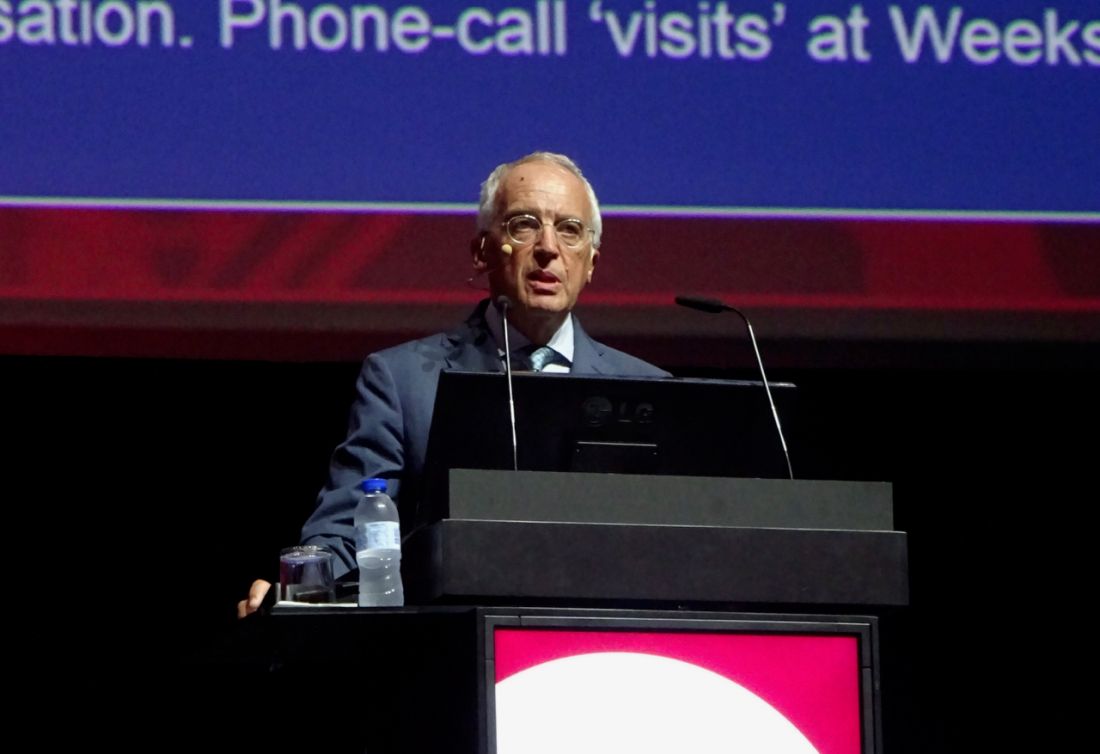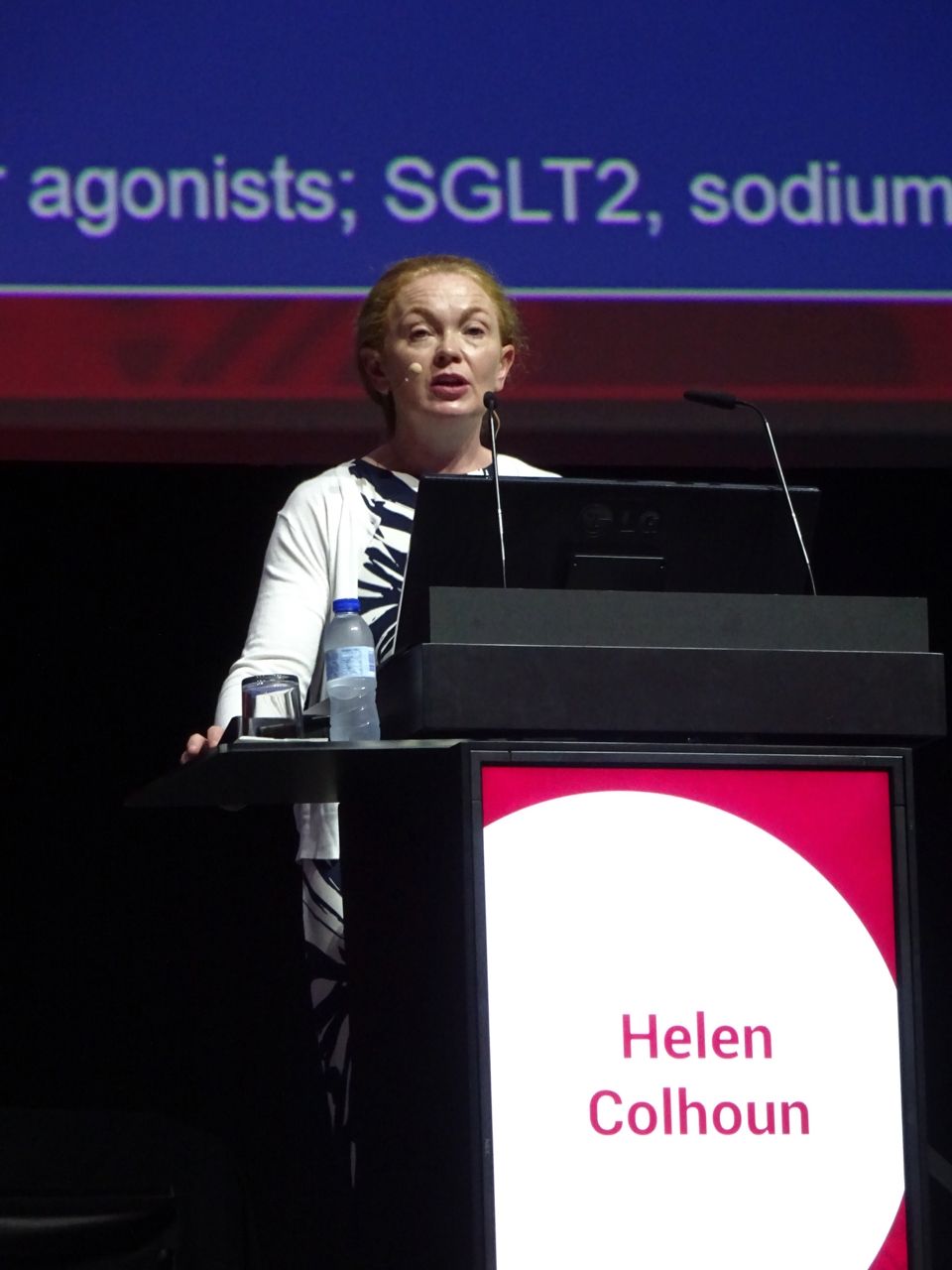LISBON – , plus it may have an edge over using older, add-on lipid-lowering therapies such as fibrates.
The findings were presented at the annual meeting of the European Association for the Study of Diabetes.
In one study involving 76 insulin-treated patients with T1DM, treatment with alirocumab (Praluent, Sanofi/Regeneron Pharmaceuticals) reduced low-density lipoprotein cholesterol levels by a mean of 47.8% versus placebo from baseline to week 24 (P less than .0001), the primary endpoint of the study.
Furthermore, in a separate study involving 413 patients with T2DM with mixed hyperlipidemia, alirocumab decreased levels of non–high-density lipoprotein cholesterol (non-HDL-C) by 33.3% compared with fenofibrate (P less than .0001).
These new results from the ODYSSEY DM-INSULIN and ODYSSEY DM-DYSLIPIDEMIA trials, respectively, add to those already presented this year at the annual scientific sessions of the American Diabetes Association.
At the ADA meeting it was reported that, after 24 weeks, alirocumab therapy cut LDL-C by 49% more than placebo (P less than .0001) in insulin-treated patients with T2DM, and that non-HDL-C fell by 32.5% more compared with usual care (P less than .0001) in the lipid trial.“We have studied two groups of high- to very-high cardiovascular risk patients with diabetes mellitus: those on insulin and those with mixed dyslipidemia in whom previously only secondary data were available,” said Stefano Del Prato, MD, who presented the lipid study. “These are dedicated studies in these specific populations,” he added.
In these high-risk diabetic populations, Dr. Del Prato, professor of endocrinology and metabolism and chief of the section of diabetes, University of Pisa, Italy, observed “alirocumab was superior in lipid-lowering efficacy compared to standard care, with no specific safety issues.”
Efficacy unaffected by co-administration with insulin use
Helen Colhoun, MD, AXA chair of medical informatics and life course epidemiology at the University of Edinburgh, presented the updated findings of the ODYSSEY DM-INSULIN study, which recruited 517 patients, the majority (n = 441) of whom had T2DM.
In the study, alirocumab, a monoclonal antibody that targets proprotein convertase subtilisin–kexin type 9 (PCSK9), was compared with placebo in patients with established atherosclerotic cardiovascular disease or other cardiovascular risk factors, and in whom LDL-C was 70 mg/dL (1.8 mmol/L) or higher.
The percentage change in LDL-C from baseline to week 24 was similarly reduced in T1DM and T2DM, Dr. Colhoun observed, and commensurate with data seen across the ODYSSEY phase III trials program. Of note, the majority of type 2 (80%) and type 1 (63%) patients did not need the dose of alirocumab to be increased and remained on the starting dose of 75 mg every 2 weeks.
“It is very pleasing to see no evidence of loss of efficacy of alirocumab among people with type 1 diabetes,” Dr. Colhoun said. Despite the “modest sample size, you can see the treatment effect is highly, clinically, and statistically significant.”The results of the ODYSSEY DM-INSULIN trial, which were published online, Sept. 14, 2017, to coincide with their presentation at the meeting, also showed that the percentage change in LDL-C over time is “well sustained” and that 70% and 76% of patients with T1DM and T2DM, respectively, can achieve an LDL-C target of less than 70 mg/dL (1.8 mmol/L) and 79% and 71% can hit a non-HDL-C target of less than 100 mg/dL (2.6 mmol/L).
Other lipid parameters – including apolipoprotein (Apo) B, total cholesterol, Lp(a), and triglycerides – were also reduced to a greater extent in patients treated with alirocumab versus those given placebo. Dr. Colhoun drew attention to the reduction in Lp(a), which dropped by 23% in patients with T1DM and by 19% in patients with T2DM, as it is an important risk factor for peripheral vascular disease, and it is not affected by statin therapy.
“What this trial has told us is that coadministering alirocumab with insulin does not adversely affect its efficacy,” said Dr. Colhoun. “There’s absolutely no evidence of alirocumab altering HbA1c or fasting plasma glucose,” she added. There was also no affect on how patients were treated, either with insulin therapy or antihyperglycemic drugs.
Overall safety findings were “reassuring” and anti-drug antibodies were rare (2.1%) and did not affect the lipid-lowering effects of alirocumab.



